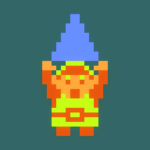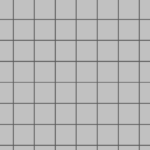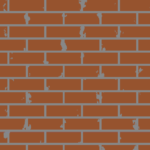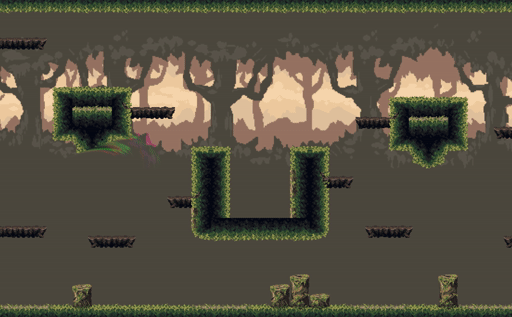Brick/tiled wall
Quickly make a brick wall and adjust it to fit the look you are going for. Add some roughness to break up the patterns. Several parameters to adjust:
- Size – The size of the bricks.
- Thickness – Thickness of the “mortar”, the lines between the bricks.
- Symmetry – Offset every other line to make classic brick pattern or lined up squares.
- Ratio – The width and height ratio of the bricks. 1 x 1 is a square tile.
- Brick Color – Color of the brick shape.
- Mortar Color – Color of the lines between the bricks.
- Rough Noise – The texture that defines the roughness look. To start, add an OpenSimplexNoise and set ‘Height’ to 200, ‘Period’ to 15 and ‘Lacunarity’ to 3.
- Rough Amount – How rough do you want it to look.
Add the shader code to any Sprite. Make sure the Sprite has a texture. Add this code snippet to the Sprite. It will send the sprite’s scale value to the shader so that the tile’s aspect ratio remains when rescaling the node. You might have to reload the scene for the tool keyword to trigger.
tool
extends Sprite
func _ready():
set_notify_transform(true)
func _notification(what):
if what == NOTIFICATION_TRANSFORM_CHANGED:
get_material().set_shader_param("scale", scale)Shader code
/*
Shader from Godot Shaders - the free shader library.
godotshaders.com/shader/brick-tiles
Feel free to improve and change this shader according to your needs
and consider sharing the modified result on godotshaders.com.
Tiling effect from https://thebookofshaders.com/09/
*/
shader_type canvas_item;
uniform float size = 5.0;
uniform float thickness : hint_range (0.0, 0.5) = 0.08;
uniform float symmetry : hint_range(0.0, 2.0) = 1.0;
uniform vec2 ratio = vec2(0.5, 1.0);
uniform vec4 brick_color : hint_color = vec4(0.52, 0.28, 0.18, 1.0);
uniform vec4 mortar_color : hint_color = vec4(0.55, 0.55, 0.55, 1.0);
uniform sampler2D rough_noise; // Add an OpenSimplexNoise and set 'Height' to 200, 'Period' to 15 and 'Lacunarity' to 3
uniform float rough_amount : hint_range(0.0, 2.0) = 1.0;
uniform vec2 scale = vec2(1.0); // Don't edit this, it is used by the script to get the nodes scale.
vec2 brick_tile(vec2 _st, float _zoom)
{
_st *= _zoom;
// Here is where the offset is happening
_st.x += (step(1.0, mod(_st.y, 2.0)) * 0.5) * symmetry;
return fract(_st);
}
float box(vec2 _st, vec2 _size, vec2 _ratio)
{
_size = (vec2(0.5, 0.5) * _size * _ratio);
vec2 uv = smoothstep(_size, _size + vec2(1e-4), _st);
uv *= smoothstep(_size, _size + vec2(1e-4), (vec2(1.0) - _st));
return uv.x * uv.y;
}
vec3 uneven(vec2 _st, vec2 _uv, float _rough_amount)
{
// This function works by practically making the lines again but with smooth edges
// and multiplying a noise texture to it. Add an OpenSimplexNoise to 'rough_noise'.
// Adjust the values or make your own function completely and play with the values, both in this
// function but also in the noise texture.
//
// In the Noise texture, start with setting 'Period' to 15 and 'Lacunarity' to 3.
vec2 _size = vec2(_rough_amount) * ratio;
vec2 uv = smoothstep(vec2(0.0), _size , _st);
uv *= smoothstep(vec2(0.0), _size , (vec2(1.0) - _st));
vec2 fringe = uv;
vec3 rough_text = texture(rough_noise, _uv).rgb;
rough_text += vec3(fringe.r);
rough_text = smoothstep(0.35, 0.4, rough_text);
return rough_text;
}
void fragment()
{
// To make the pattern keep its proportions even when resizing the texture,
// add a script with this code to the node:
/*
tool
extends Sprite
func _ready():
set_notify_transform(true)
func _notification(what):
if what == NOTIFICATION_TRANSFORM_CHANGED:
get_material().set_shader_param("scale", scale)
*/
// Set the brick shape
vec2 shape_uv = UV * scale * ratio;
// Create the brick tiling
shape_uv = brick_tile(shape_uv, size);
// Apply some grungy uneveness. You can play around with the values in the 'uneven' function for other results
vec3 edge = vec3(uneven(shape_uv, UV, rough_amount));
// Create the "mortar" lines
vec3 color = vec3(box(shape_uv, vec2(thickness), ratio)) * vec3(edge);
// Apply the colors
color = mix(mortar_color.rgb, brick_color.rgb, color.r);
// Uncomment to see the space coordinates. This is quite neat and can give you an idea of how the shader works.
//color = vec3(shape_uv, 0.0);
COLOR = vec4(color, 1.0);
}












